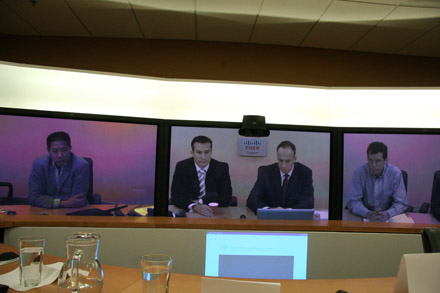June Aussie launch for Cisco's blades

Australia will be accessing the last block in Cisco's unified computing strategy, its own blade servers, at the same time as the rest of the world, according to executives speaking today.

The Cisco media conference held via telepresence
(Credit: Suzanne Tindal/ZDNet.com.au)
The company's blade servers, based on Intel's Nehalem processor and with an extended memory technology that Cisco claims provides more virtual machines per server than other models, will be able to be ordered from 17 April and will ship in June, according to Andre Smit, Cisco managing director, datacentre sales Asia-Pacific. Pricing will not be released until that point.
The shipping will take two to three weeks, Cisco datacentre leader Australia New Zealand Dylan Morrison told ZDNet.com.au, and customers would be able to fit them into their datacentres and gain the full benefit of the company's unified computing strategy within a few weeks of receiving them.
The servers are the last portion of the strategy, which Cisco claims will provide a single cohesive architecture for datacentres which will solve management problems it said customers had been having with virtualisation.
The forerunners of the strategy have included the Nexus 5000 switches, which allow the construction of a unified switching fabric combining Ethernet and FibreChannel, as well as the Nexus 1000v which allows IT managers to manage lots of servers with multiple virtual machines as one big network and not as separate environments.
In Australia, Dimension Data and Alphawest will be working with Cisco on the systems integration side for the strategy, while Wipro, Tata and Accenture will help with business consulting services.
There are another three technology partners currently in the Asia-Pacific region, and in six months Cisco will be adding another 15. Partners are chosen on whether they can approach the customers with one voice, breaking down silos internally which would have the companies approaching customers from a network or storage angle.
Cisco is targeting customers whose datacentres run virtualised platforms, have applications requiring high amounts of memory or have a service provider model. Cisco hopes this segment will be worth US$330 million to it in Australia and New Zealand by 2010.
There are some customers currently in Australia who are running beta programs for the strategy, but Cisco was unable to say who they were or how many there were. There were also no Australian ROI figures available. "It's early days for us in Australia of working right through to the conclusion of actually calculating an ROI," Pete Nicholls, Asia-Pacific Cisco business development manager (datacentres) said.
Despite this, the company seemed to believe the return on investment for companies buying its products would be around 12 months, something Nicholls saw as necessary in the current environment. "It's very difficult for IT to get sign off on projects that don't get an ROI in nine to 18 months," he said.
ZDNet.com.au has been told no review units will be given out to reviewers outside the US.